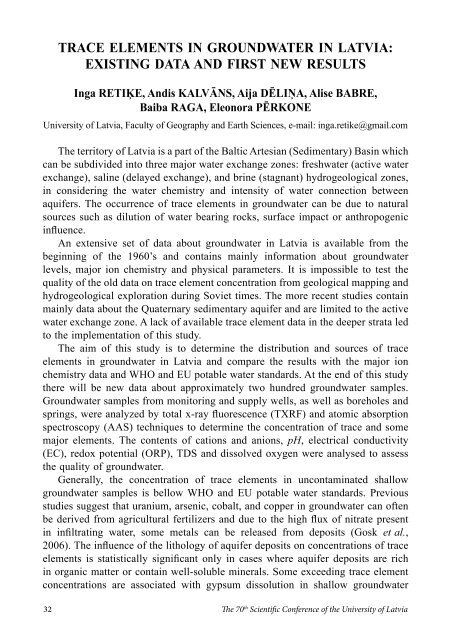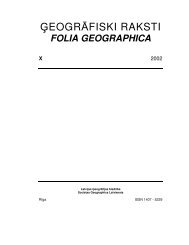Section âGroundwater in Sedimentary Basinsâ - Latvijas UniversitÄte
Section âGroundwater in Sedimentary Basinsâ - Latvijas UniversitÄte
Section âGroundwater in Sedimentary Basinsâ - Latvijas UniversitÄte
You also want an ePaper? Increase the reach of your titles
YUMPU automatically turns print PDFs into web optimized ePapers that Google loves.
TRACE ELEMENTS IN GROUNDWATER IN LATVIA:EXISTING DATA AND FIRST NEW RESULTSInga RETIĶE, Andis KALVĀNS, Aija DĒLIŅA, Alise BABRE,Baiba RAGA, Eleonora PĒRKONEUniversity of Latvia, Faculty of Geography and Earth Sciences, e-mail: <strong>in</strong>ga.retike@gmail.comThe territory of Latvia is a part of the Baltic Artesian (<strong>Sedimentary</strong>) Bas<strong>in</strong> whichcan be subdivided <strong>in</strong>to three major water exchange zones: freshwater (active waterexchange), sal<strong>in</strong>e (delayed exchange), and br<strong>in</strong>e (stagnant) hydrogeological zones,<strong>in</strong> consider<strong>in</strong>g the water chemistry and <strong>in</strong>tensity of water connection betweenaquifers. The occurrence of trace elements <strong>in</strong> groundwater can be due to naturalsources such as dilution of water bear<strong>in</strong>g rocks, surface impact or anthropogenic<strong>in</strong>fluence.An extensive set of data about groundwater <strong>in</strong> Latvia is available from thebeg<strong>in</strong>n<strong>in</strong>g of the 1960’s and conta<strong>in</strong>s ma<strong>in</strong>ly <strong>in</strong>formation about groundwaterlevels, major ion chemistry and physical parameters. It is impossible to test thequality of the old data on trace element concentration from geological mapp<strong>in</strong>g andhydrogeological exploration dur<strong>in</strong>g Soviet times. The more recent studies conta<strong>in</strong>ma<strong>in</strong>ly data about the Quaternary sedimentary aquifer and are limited to the activewater exchange zone. A lack of available trace element data <strong>in</strong> the deeper strata ledto the implementation of this study.The aim of this study is to determ<strong>in</strong>e the distribution and sources of traceelements <strong>in</strong> groundwater <strong>in</strong> Latvia and compare the results with the major ionchemistry data and WHO and EU potable water standards. At the end of this studythere will be new data about approximately two hundred groundwater samples.Groundwater samples from monitor<strong>in</strong>g and supply wells, as well as boreholes andspr<strong>in</strong>gs, were analyzed by total x-ray fluorescence (TXRF) and atomic absorptionspectroscopy (AAS) techniques to determ<strong>in</strong>e the concentration of trace and somemajor elements. The contents of cations and anions, pH, electrical conductivity(EC), redox potential (ORP), TDS and dissolved oxygen were analysed to assessthe quality of groundwater.Generally, the concentration of trace elements <strong>in</strong> uncontam<strong>in</strong>ated shallowgroundwater samples is bellow WHO and EU potable water standards. Previousstudies suggest that uranium, arsenic, cobalt, and copper <strong>in</strong> groundwater can oftenbe derived from agricultural fertilizers and due to the high flux of nitrate present<strong>in</strong> <strong>in</strong>filtrat<strong>in</strong>g water, some metals can be released from deposits (Gosk et al.,2006). The <strong>in</strong>fluence of the lithology of aquifer deposits on concentrations of traceelements is statistically significant only <strong>in</strong> cases where aquifer deposits are rich<strong>in</strong> organic matter or conta<strong>in</strong> well-soluble m<strong>in</strong>erals. Some exceed<strong>in</strong>g trace elementconcentrations are associated with gypsum dissolution <strong>in</strong> shallow groundwater32 The 70 th Scientific Conference of the University of Latvia
















